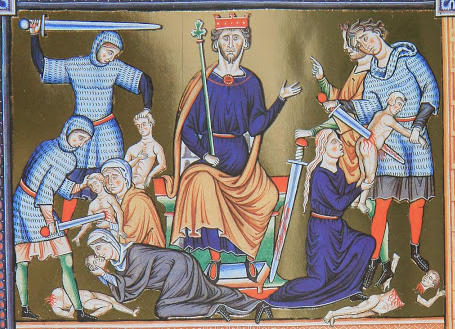
Create an Amazon Wedding Registry
Musée Condé MS.9
Massacre of the Innocents,
Ingeborg Psalter,
Northern France, c.1195AD



The Ingeborg Psalter is a late 12th century illuminated Psalter now housed in the Musée Condé of Chantilly, France. It was created about 1195 in northern France for Ingeborg of Denmark, wife of King Philip II of France. It is unknown who commissioned the Psalter for Ingeborg, but it may have been commissioned by either Stephen of Tournai or Eleanor of Vernandois, Countess of Beaumont-sur-Oise. It is one of the most significant surviving examples of early Gothic painting.
The manuscript was prayerbook for private devotionals and contains a calendar, the 150 Psalms in Latin plus other liturgical texts. There are 200 extent folios. The text is written in an early Gothic minuscule.
Scholars named the Master of the Ingeborg Psalter for a manuscript of the psalms he illuminated, together with another painter, for Queen Ingeborg of France. In the years around 1200, he was active in northeastern France. The style of the Master of the Ingeborg Psalter represents a turning point in the history of European painting, when artists left behind abstract and highly stylized forms in favor of a more naturalistic representation of the visible world. The three-dimensional quality of the figures, their heroic proportions, and their expressive movements stand out as the new elements in his work, those essential to the emerging Gothic style of the early 1200s.
Referenced on p.176, Arms and Armour of the Crusading Era, 1050-1350, Western Europe and the Crusader States by David Nicolle
440A-C 'Massacre of the Innocents', Ingeborg Psalter, Germany, France or England, c.1195
(Musée Condé, Ms. 1695, f.18v, Chantilly, France)
This manuscript may have been made in a French-speaking area of the Empire, in France, or in Anglo-Norman England. It portrays rather old-fashioned mid-sleeved mail hauberks, with mail coifs having ventails laced on the right side. One such coif lies on the wearer's shoulders (C). The straight swords have large round pommels which look more French than German.